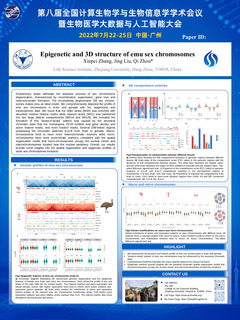Epigenetic and 3D architecture of emu sex chromosome
编号:47
稿件编号:56 访问权限:仅限参会人
更新:2022-06-28 16:54:26 浏览:1017次
张贴报告

摘要
Evolutionary strata delineate the stepwise process of sex chromosome degeneration, characterized by recombination suppression, gene loss and heterochromatin formation. The homomorphic emu ZW chromosomes make it an ideal model for the study of early sex chromosome evolution at the initial stage. Thus far, the insights into how genome architecture and chromatin states may shape the evolution of vertebrate sex chromosome remain largely unexplored. By integrating high-throughput chromosome conformation capture (Hi-C), epigenome and transcriptome data, we depict the comprehensive profile of emu sex chromosome in brain and gonads. We found emu chromosome W is composed of highly repetitive strata (WS0) and a nascent evolved stratum (WS1). The WS0 was enriched with abundant inactive histone marks while WS1 was partitioned into two large distinct compartments (WS1A and WS1B). We revealed the formation of this “strata-in-strata” pattern was caused by the ancestral chromatin state that the homologous ZS1B exhibits less gene density and active histone marks, and more inactive marks. We further identified several Z/W-linked regions possessing the chromatin switches A-to-B from brain to gonads. These regions turned out to include ovary-specific regulatory elements and are related to gonad development. Moreover, macrochromosomes tend to harbor more heterochromatic markers while microchromosomes have more euchromatic markers, consistent with the spatial organization model that microchromosomes occupy the nuclear center and macrochromosomes located near the nuclear periphery. Overall, our results provide novel insights into the spatial organization and epigenetic modifications of avian sex chromosomes evolution.
关键字
Histone modification,Evolutionary strata,Chromatin Structure
报告人

发表评论